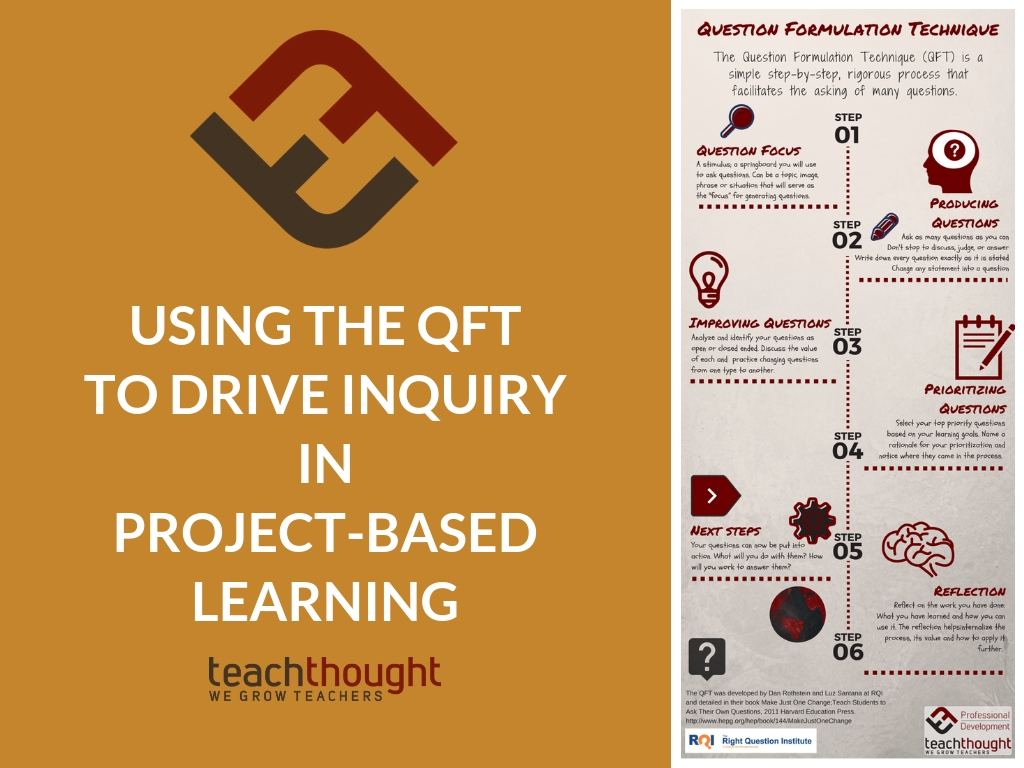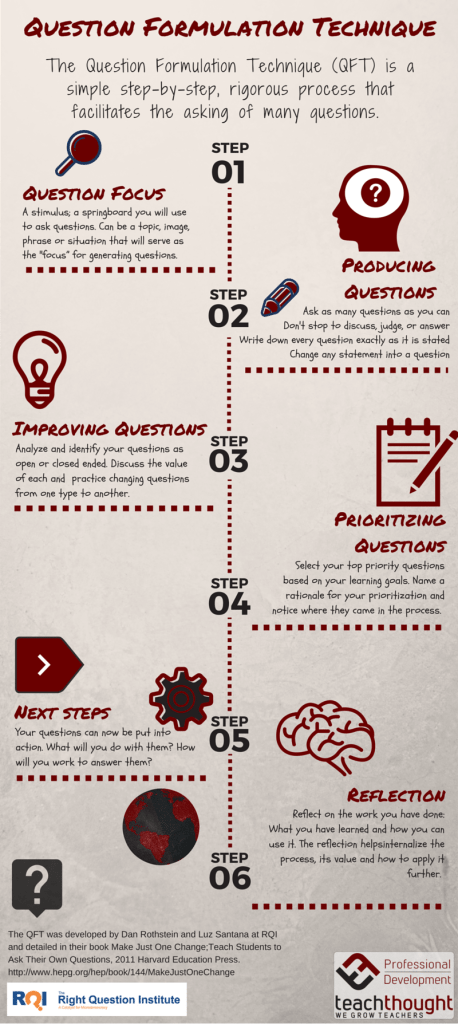
How To Drive Inquiry In Project-Based Learning With The QFT?
contributed by Drew Perkins
Inquiry can be a powerful teaching and learning strategy.
When I came across the Question Formulation Technique by the Right Question Institute while reading A More Beautiful Question by Warren Berger, I was excited for such a simple yet powerful tool to increase the quality of student inquiry. While there are many ways you can use the QFT in any classroom, and the Right Question Institute (RQI) provides some great examples on their website, it can be a valuable tool in a project-based learning setting as well.
This type of rich inquiry elevates student autonomy and collaboration in a “Yes, And” sort of way. It helps create a culture focused on safety in discovery rather than intimidating teacher coverage.

Reviewing the infographic you’ll notice the QFT starts with a Question Focus. This is something that typically pushes the learner to take a side or provoke deep thought. Students then produce questions in a sort of ‘question-storming’ way that works best when they all contribute (in small groups) on one large chart paper (see video below) or whiteboard.
The synergy that can build from this type of collaboration is powerful as students essentially ‘Yes, and…’ the thoughts of others without judging or working to answer these questions. As the RQI folks note, the shift from being asked for answers to being asked for questions can really be powerful in building a safe learning environment. As students improve and work through the remaining steps of the QFT the opportunities for meta-cognition are rich and should improve as they become more comfortable with the process.

In the course of a PBL unit, there are several phases and I can see the QFT being used in all of them. Initially, you want to create some sense of cognitive dissonance or emotional engagement around the project’s challenge or problem and the QFT can help do that by using it as an Entry Event and hook. It’s possible to use the QFT in a professional development setting to generate questions around data showing drops in student engagement and questioning over time.
As a classroom teacher, you might engage students in the QFT as a way to better understand student passions and interests (Genius Hour, for example) and use that data to design a project weeks later but using a powerful Question Focus to kick your project off can generate student interest and excitement while activating their schema and helping to start your Need to Know list.
During a project, there should be multiple opportunities for meaningful assessment as students work toward craftsmanship and refining their products. What if you used the QFT to assess student understanding of a text or teaching resource/material and generate meaningful conversation much like a Socratic Seminar might to help spur deeper learning and differentiate?
It is also possible to use the QFT process in the service of helping students struggling to move forward with an iteration or just needing peer critique and certainly in helping them add to their Need to Knows. What if you engaged students and experts collaboratively in the QFT around student products in a way that helped them display their thinking like and alongside actual content area experts?
As you’re coming to the end of your project what if, instead of giving a traditional test, you used the QFT as a summative assessment as the video below shows? While this might force you (and your students) to think differently about summative assessments, a teacher/facilitator can learn much about content understanding while engaging students in critical thinking.

Conclusion
Ultimately, the QFT is a multi-faceted tool and the beauty of it is in its simplicity. It helps students have more of a voice. It helps teachers shift from being the center of attention and thinking to the facilitator creating scenarios allowing for great questions that effective PBL demands. It also helps create a mindset and culture where students become resourceful and empowered by their inquiry because it’s just that, their inquiry. As teachers, we need to ask great questions and students to ask great questions.
They have them, but often aren’t asked to share meaningfully. Designing great learning means we’re asking questions important to our students and presenting them with opportunities to do the same. This can be a challenge at all levels but the QFT can help.
Using The QFT To Drive Inquiry In Project-Based Learning
